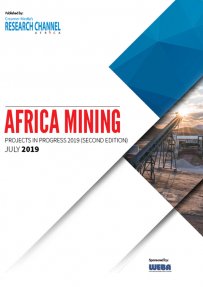NEW REPORT AVAILABLE
Africa Mining Projects in Progress 2019 (Second Edition) - PDF Report

PLEASE NOTE:
This report focuses on mining projects in African countries, outside of South Africa. For information on South African mining projects, please refer to Creamer Media’s Projects in Progress supplements, or subscribe to Creamer Media’s Research Channel Africa.
MINING IN AFRICA
The rise of green energy technologies – solar panels, wind turbines, electric vehicles, and large-scale batteries – is necessary for a low-carbon future, however, the transition from a fossil fuel base to a renewable-energy system is dependent on materials and, particularly, metals to manufacture and maintain energy conversion technologies. This is expected to lead to significant growth in demand for a wide range of minerals and metals.
Base metals, namely aluminium and copper, are essential for almost all renewable technologies, and are used in abundance compared to other metals. Other metals that are of significant importance are cobalt, lithium, nickel and manganese used in lithium-ion batteries, and silver for use in the majority of solar panels. A range of specialty metals are also used in thin-film solar panels for specialist applications.
Copper is just one of the base metals needed to manufacture electric cars and wind turbines, and it is one of the metals for which there is no good substitute.
The International Energy Agency forecasts that there will be 125-million electric vehicles (EVs) on the road by 2030, which will require an estimated ten-million tonnes of copper – a 50% increase over current yearly global copper consumption.
The additional wind turbines built by 2030 would require about two-million tonnes of copper – about 10% of the world’s current production.
This does not take into account the amount of copper that would be needed for a quadrupling of solar power, nor all the improvements to the electrical grid and EV charging infrastructure that would be required.
There are also concerns about the supply of lithium and cobalt, both of which are needed for lithium-ion batteries used in EVs.
Africa is starting to be recognised for the role it could play in providing some of these minerals and metals. The Democratic Republic of Congo, for instance, hosts more than half of the world’s cobalt reserves, it also hosts substantial copper deposits, while Zimbabwe hosts lithium deposits. The continent also hosts zinc, lead and tin deposits from which silver is often mined as a by-product and which is used in 95% of solar photovoltaic panels.
These metals and minerals, among others, could further unlock Africa’s potential mineral development as the world progresses towards a carbon-neutral future. However, while the demand for minerals and metals provides economic opportunities for resource-rich developing countries and private-sector entities alike, major challenges will arise and need to be managed responsibly and sustainably as the climate-driven clean energy transition unfolds.
As the World Bank notes in its 2017 ‘The Growing Role of Minerals and Metals for a Low Carbon Future’ report: “Without climate-smart mining practices, negative impacts from mining activities will increase, affecting already-vulnerable communities in developing countries, as well as the environment in which they operate.”
Published on 22 July 2019.






